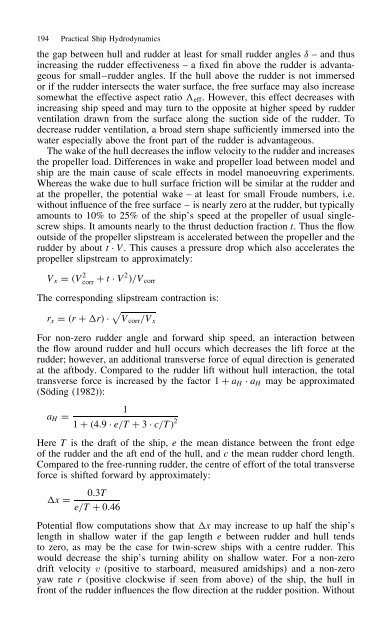Practical Ship Hydrodynamics
Practical Ship Hydrodynamics
Practical Ship Hydrodynamics
You also want an ePaper? Increase the reach of your titles
YUMPU automatically turns print PDFs into web optimized ePapers that Google loves.
194 <strong>Practical</strong> <strong>Ship</strong> <strong>Hydrodynamics</strong><br />
the gap between hull and rudder at least for small rudder angles υ – and thus<br />
increasing the rudder effectiveness – a fixed fin above the rudder is advantageous<br />
for small–rudder angles. If the hull above the rudder is not immersed<br />
or if the rudder intersects the water surface, the free surface may also increase<br />
somewhat the effective aspect ratio 3eff. However, this effect decreases with<br />
increasing ship speed and may turn to the opposite at higher speed by rudder<br />
ventilation drawn from the surface along the suction side of the rudder. To<br />
decrease rudder ventilation, a broad stern shape sufficiently immersed into the<br />
water especially above the front part of the rudder is advantageous.<br />
The wake of the hull decreases the inflow velocity to the rudder and increases<br />
the propeller load. Differences in wake and propeller load between model and<br />
ship are the main cause of scale effects in model manoeuvring experiments.<br />
Whereas the wake due to hull surface friction will be similar at the rudder and<br />
at the propeller, the potential wake – at least for small Froude numbers, i.e.<br />
without influence of the free surface – is nearly zero at the rudder, but typically<br />
amounts to 10% to 25% of the ship’s speed at the propeller of usual singlescrew<br />
ships. It amounts nearly to the thrust deduction fraction t. Thus the flow<br />
outside of the propeller slipstream is accelerated between the propeller and the<br />
rudder by about t Ð V. This causes a pressure drop which also accelerates the<br />
propeller slipstream to approximately:<br />
Vx D ⊲V 2 corr C t Ð V2 ⊳/Vcorr<br />
The corresponding slipstream contraction is:<br />
rx D ⊲r C 1r⊳ Ð � Vcorr/Vx<br />
For non-zero rudder angle and forward ship speed, an interaction between<br />
the flow around rudder and hull occurs which decreases the lift force at the<br />
rudder; however, an additional transverse force of equal direction is generated<br />
at the aftbody. Compared to the rudder lift without hull interaction, the total<br />
transverse force is increased by the factor 1 C aH Ð aH may be approximated<br />
(Söding (1982)):<br />
1<br />
aH D<br />
1 C ⊲4.9 Ð e/T C 3 Ð c/T⊳ 2<br />
Here T is the draft of the ship, e the mean distance between the front edge<br />
of the rudder and the aft end of the hull, and c the mean rudder chord length.<br />
Compared to the free-running rudder, the centre of effort of the total transverse<br />
force is shifted forward by approximately:<br />
1x D<br />
0.3T<br />
e/T C 0.46<br />
Potential flow computations show that 1x mayincreasetouphalftheship’s<br />
length in shallow water if the gap length e between rudder and hull tends<br />
to zero, as may be the case for twin-screw ships with a centre rudder. This<br />
would decrease the ship’s turning ability on shallow water. For a non-zero<br />
drift velocity v (positive to starboard, measured amidships) and a non-zero<br />
yaw rate r (positive clockwise if seen from above) of the ship, the hull in<br />
front of the rudder influences the flow direction at the rudder position. Without
















